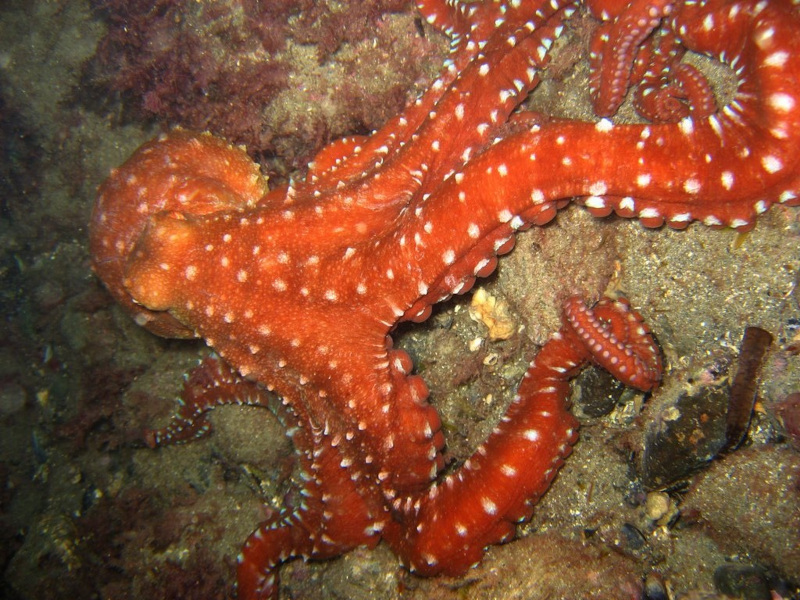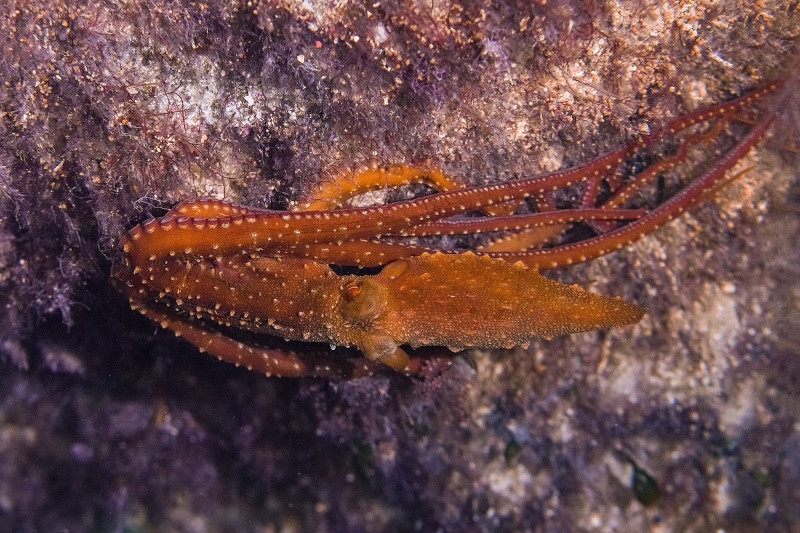Atlantic White-Spotted Octopus Facts
- This dazzling cephalopd most frequently goes by the descriptive common name of the Atlantic White-Spotted Octopus for obvious reasons. It also has another, quite similar familiar name. That, though, is simply the less informative White-Spotted Octopus.
- At least two other alternate, non-technical terms also exist for the distinctive octopus. These, however, aren’t at all like the others. They include the terms grass scuttle and grass octopus. Whichever of these one uses, though, it remains a remarkable animal.
- Meanwhile, professionals, such as researchers, typically use its formal name when referring to the creature. That term’s difficult for non-professionals to pronounce, though. This is because it bears the official moniker of the Callistoctopus macropus.
- It received that name due to the efforts of the respected French naturalist, Giuseppe Antonio Risso. He recorded the first official recognition of it as a separate and distinct species. The researcher accomplished that scientifically noteworthy deed in 1826.
- Luckily, the Atlantic White-Spotted Octopus appears to be maintaining a population base that’s both stable and sufficient. This also seems to hold true throughout its native range. The IUCN, therefore, presently lists the animal as Least Concern.
- The intriguing invertebrate nevertheless should be considered to be facing at least some threats to its existence. Habitat loss due to human expansion may someday pose a threat. Its greatest danger, though, perhaps come from ongoing climate change.
Related Articles
Atlantic White-Spotted Octopus Physical Description
The aptly-named Atlantic White-Spotted Octopus serves as an excellent example of the fact that Nature places no importance on physical dimensions. That’s because, though it easily impresses those who encounter it, the animal does not do so due to sheer physical size.
Like most of its many relatives, this octopus does display the physiological characteristic of sexual dimorphism. In its case, however, the degree of difference remains so slight as to render the genders virtually indistinguishable to the untrained observer.
The central body mass, known as the mantle, attains an average length of about 8 in (20 cm). Its length, in terms of its extended arms, however, becomes somewhat hard to define. That’s due to variations in the lengths of the various pairs of arms the animal develops.
That’s because the first pair grows to a significantly greater length than the rest. These reach an average length of around 3.3 ft (1 m). The three other pairs of tentacles, though, stay much shorter. The resulting total length averages approximately 59 in (1.5 m).
The wonders of the Atlantic White-Spotted Octopus don’t simply end there, however. The entire group of eight tentacles possesses by the wonder of Nature and evolution develop as connected by a shallow web of flesh. This makes it a variety of blanket octopus.
The physical attribute that garners the most attention, though, remains its general appearance. The overall color scheme consists of a light red. White splotches also appear on the body. It’s the numerous white spots on the arms, though, that earn the name.
- Kingdom: Animalia
- Phylum: Mollusca
- Class: Cephalopoda
- Order: Octopoda
- Family: Octopodidae
- Genus: Callistoctopus
- Species: C. macropus
Atlantic White-Spotted Octopus Distribution and Ecology
Thankfully, the distinctive Atlantic White-Spotted Octopus evolved as endemic to a moderately large portion of the marine areas of the world. For the moment, no evidence exists that it ever possessed a more extensive range. Research remains ongoing, however.
All known populations of this species of octopus appear in portions of two seas and one ocean. One grouping of specimens live in the Mediterranean Sea. Smaller population concentrations also make their home in parts of the Atlantic Ocean and Caribbean Sea.
Yet, even within these regions, the animal displays decided preferences for its choice of specific habitat. Individuals only reside in the temperate and tropical portions of these three regions. Its most favored habitats seem to consist of rubble, sand, or seagrass meadows.
It also displays precise preferences in terms of the depths at which it makes its home. At its shallowest, this range extends all the way to the waterline, near the shore itself. Yet, at its most extreme limits of its range, it never appears at depths beyond 56 ft (17 m).
The tantalizing Atlantic White-Spotted Octopus also evolved another trait that distinguishes it from most of its kindred. That’s true due to the fact that it’s much more selective in its feeding habits. It generally feeds on small fish and invertebrates hiding among coral.
Following mating, the female attaches groups of eggs onto a hard surface, forming a sheet of them. She remains, however, to watch over and protect them. Yet, she also ceases to eat at this time. Consequently, she typically dies soon after the numerous eggs hatch.
Species Sharing Its Range
Check out our other articles on 5 Surprising Freshwater Animals, Wilson’s Bird-of-paradise, Victoria Falls, Smooth Purple Coneflower, Blainville’s Beaked Whale, Purple Frog, Texas Alligator Lizard


